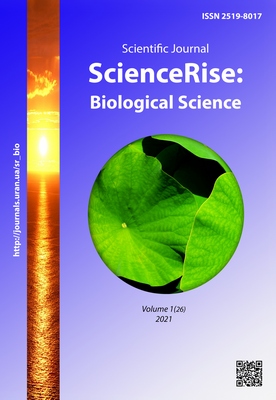Application of laboratory beta radiometry for quantitative indication of radionuclide concentration in plant samples
DOI:
https://doi.org/10.15587/2519-8025.2021.228646Keywords:
Chernobyl exclusion zone, 90Sr, 137Cs, plants, radioecology, beta-radiometry, radiospectrometryAbstract
The aim is to improve the beta-radiometric method of quantitative indication of the content of 90Sr and 137Cs in the counters of plant samples.
Material and methods. In the Chernobyl exclusion zone (ChEZ) in 2017, 2019, leaves of silver birch, black poplar, common reed, sedge were selected, which were dried, crushed, and used as calculating samples for beta radiometry and spectrometry. For measurements, a combined KRK-1 radiometer and a SEB 01-150 spectrometer beta-radiation energy were used.
Results. Currently, in plant samples from the ChEZ, the following are widespread: natural 40K, the concentration of which is usually less than 1 % in relation to the concentration of technogenic radionuclides 90Sr+90Y and 137Cs, therefore, when measuring 90Sr and 137Cs, beta radiation of 40K can be ignored. The measurements were carried out without a spectral filter and using a thin molybdenum filter. Without filter – show the count rate of 90Sr+90Y and 137Cs radiation. The filter transmits 2–3.5 % of the low-energy beta radiation of 90Sr and 137Cs and more than 95 % of the high-energy 90Y. The ratio of the count rate of 90Y pulses with and without filter is 2.14. The 90Sr concentration in the samples was determined from the results of measurements of 90Y, and 137Cs – through the fraction of the counting rate, which remains after deducting 90Sr+90Y. Comparison of the concentration of radionuclides measured by the method of beta-radiometry and spectrometry showed no significant difference between the results obtained by the two methods.
Conclusions. The beta radiometry method for 90Sr and 137Cs provides for measuring the counting rate of beta radiation from counting samples without a spectral filter and using a thin molybdenum filter. Based on the research results, a procedure for calculating the concentration of 90Sr and 137Cs in counting samples of plant leaves was developed
References
- Hou, X., Roos, P. (2008). Critical comparison of radiometric and mass spectrometric methods for the determination of radionuclides in environmental, biological and nuclear waste samples. Analytica Chimica Acta, 608 (2), 105–139. doi: http://doi.org/10.1016/j.aca.2007.12.012
- Maksimov, M. T., Odjagov, G. O. (1989). Radioactive contamination and their measurement. Moscow: Energoatomizdat, 2, 304.
- Cherniavskyi, Y. Yu., Cherniavskyi, O. Yu., Pysarev, S. A., Halak, A. V. (2015). Accounting of mixed radiation during the measurement radioactive contamination of different subjects in field conditions. Zbirnyk naukovykh prats Kharkivskoho universytetu Povitrianykh Syl, 2 (43), 159–165.
- Sahin, S., Kursat, M., Yilmaz, E., Kuluozturk, M. H. (2016). Determination of the gross alpha-beta radioactivity levels in some of medicinal and aromatic plants. Applied Science Reports, 14 (2), 202–206. doi: http://doi.org/10.15192/pscp.asr.2016.14.2.202206
- Radiometri kombinirovannie KRK-1. Tekhnicheskoe opisanie i instruktsiia po ekspluatatsii. 1.287.603 TO, 47.
- Rubinstein, R. Y., Kroese, D. P. (2017). Simulation and the Monte Carlo method. John Wiley & Sons, 396.
- Hanzha, D. D., Hanzha, D. D. (2015). The accumulation of radionuclides, potassium, calcium ions in leaves of Phragmites australis (Cav.) Trin. ex Steud. Naukovi zapysky Ternopilskoho natsionalnoho pedahohichnoho universytetu imeni Volodymyra Hnatiuka. Hidroekolohiia, 3/4 (64), 119–122.
- Ganzha, D. D., Ganzha, D. D., Nazarov, A. B. (2020). The tensile breaking strenght of Phragmites Australis (CAV.) TRIN. EX STEUD. leaves as a chronic irradiation effect. RAP Conference Proceedings, 4, 103–107. doi: http://doi.org/10.37392/rapproc.2019.20
- Be, M. M., Chiste, V., Dulien, C. et. al. (2004). Table of radionuclides (comments of evaluation). Monographie BIPM-5, Pavillon de Breteuil, 494.
- Ganzha, C. D., Gudkov, D. I., Ganzha, D. D., Nazarov, A. B. (2020). Accumulation and distribution of radionuclides in higher aquatic plants during the vegetation period. Journal of Environmental Radioactivity, 222, 106361. doi: http://doi.org/10.1016/j.jenvrad.2020.106361
- Levchuk, S. (2016). Dovidnyk po osnovnykh metodakh vyznachannia aktyvnosti radionuklidiv. Natsionalnyi universytet bioresursiv i pryrodokorystuvannia Ukrainy. Kyiv, 119.
- Babenko, V. V., Kazymyrov, A. S., Rudik, A. F. (2001). Beta-spektrometryia prob okruzhaiushchei sredi. Mizhnarodne spivrobitnytstvo v Chornobyli. Kyiv, 477–493.
Downloads
Published
How to Cite
Issue
Section
License
Copyright (c) 2021 Dmitro Ganzha, Dmytro Ganzha, Borys Sploshnoy

This work is licensed under a Creative Commons Attribution 4.0 International License.
Our journal abides by the Creative Commons CC BY copyright rights and permissions for open access journals.
Authors, who are published in this journal, agree to the following conditions:
1. The authors reserve the right to authorship of the work and pass the first publication right of this work to the journal under the terms of a Creative Commons CC BY, which allows others to freely distribute the published research with the obligatory reference to the authors of the original work and the first publication of the work in this journal.
2. The authors have the right to conclude separate supplement agreements that relate to non-exclusive work distribution in the form in which it has been published by the journal (for example, to upload the work to the online storage of the journal or publish it as part of a monograph), provided that the reference to the first publication of the work in this journal is included.









